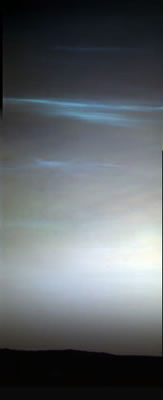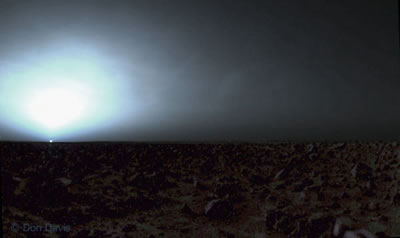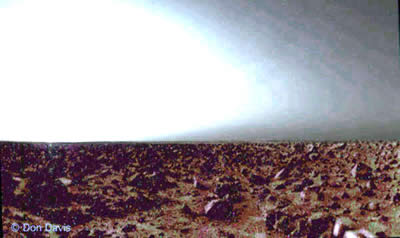
A September 3, 2003 article in the 'Enterprise Mission' web site, seen here, used some of my Mars images without permission, complete with copyright notices, to attempt to support some weird theories regarding Cydonia. I disagree with the conclusions of the article and disapprove of my images being appropriated to attempt to support them. My work attempts to incorporate factual information in order to show what space subjects could look like to conceivable future human observers. I am not associated with his sensationalistic cause nor have I worked with him since he abandoned mainstream science. I illustrated some of his science articles on Saturn, Europa, and the exotic star system SS433 for the defunct magazine 'Star and Sky' about 20 years ago, before the 'Face On Mars' demon possessed him. In 1984 he tried to interest me in his 'face on Mars' cause which I initially had a hard time believing he was seriously advocating. I am offended by his attempt to use my work in support of the bizzare ideas he presents on his site and on 'Coast To Coast' AM Radio. He has refused (as of Oct 1 2003) to remove my images after I contacted him about this.
I offer here my comments below on my images he appropriated for his article since I prepared them myself and thus can offer insights on what they do and do not show. The text in the 'Enterprise' article discussing my images is included along with the pictures in question, with my comments shown in type of this size. The original page my images were taken from can be seen here, as part of my article on Planetary color. Hoagland feels free to use material from my site, so I will quote from his article which used my work, although I will pay him more courtesy than he has done for me by not using his images.

In this Viking 1 post-sunset surface view (above),
prepared by former USGS graphic artist Don Davis, note how the
sky remains bright well after the sun sets on Mars (sunset, of
course, is merely the opposite condition to sunrise;
therefore a post sunset image is optically equivalent to a pre-dawn
image at the same location and time) The
bluish "afterglow" several degrees above the sunset
point on Mars is due to the unique "forward scattering"
properties of the much thinner Martian atmosphere, which is filled
with varying amounts of finely-divided dust (in the
official model) - preferentially scattering blue light forward
toward the camera .
The major thing to note in this image is the
Lander wind cover on the Viking nuclear power generator (light
ellipse --
far right): notice that it is just barely visible in this twilight
Mars illumination even though the lighting geometry is
ideal for so-called "specular reflection" (the light
above the setting sun should be bouncing directly toward the
camera) and the cover itself is painted brilliant white!
Yet, as can be seen, under this illumination this white wind cover is barely noticeable!
This image was prepared to attempt to reconstruct the color of the Martian skies which were given a grossly striped appearance by the limited 64 gray steps available for each color channel in the original Viking lander cameras. The image faintly shows lander details directly opposite the Sun, with the horizontal surfaces reflecting the brighter forward scattered sky light. PC based equipment may produce a darker image than on Macs, on which my work is done. The lander was uniformly painted a dull battleship gray of about 50 percent brightness, with a flat finish rubberized paint. It is not shiny at all, although the paint is brighter than the average Martian surroundings.
Why, under identical lighting (CYDONIA IMAGES DELETED) is
the Face- even allowing for the obviously increased gain settings
in the
Odyssey camera (to bring out the darker western side) -- so incredibly
bright? And why is that inexplicably reflective
eastern surface also arrayed in those stark startlingly geometric
patterns?
Determining if the lighting was indeed 'identical' between the two photographic situations on a planet with such variable weather as Mars is impossible due to variable weather and dust content of the atmosphere. The Mars Odyssey VIS camera color images require further refinement before confident color analysis based on those images can be reliably attempted. The additional hazards of trying to read too much into what is seen at the threshold of the resolution of a given image are well worth keeping in mind. If you torture the data enough it will confess whatever you want to be told.
Another pre-dawn image (below), this one from
Mars Pathfinder, reinforces this enigma: an obviously almost
un-illuminated landscape, lit only by the sky, clearly incapable
of presenting such dramatic surface differences as
seen in the Odyssey Cydonia image .
The Pathfinder twilight image was exposed for a bright sky. Anyone trying to photograph the twilight on Earth will have a similar choice between exposing for the sky or for the silhouetted foreground. From above the site it is probable that topography would have been visible to a suitable camera. Various images from Mars orbit show detailed relief even when the Sun is just below the local horizon. Here is an example.

But it's a Viking 2 sunrise shot that best illustrates this major new Cydonia mystery.

As you can see (above), even with the sun actually on the horizon,
the overall illumination of the surface landscape
in this Viking 2 dawn image is extremely dark -- a combination
of dust absorption of sunlight at the horizon, and an
extremely thin Martian atmosphere.
I processed the ground portion of the Viking 2 photo separately from the sky in order to bring out marginal detail visible in the raw data. Previous released versions of this and similar images from Viking 2 generally show no scenery details at all. My earlier comments on exposure factors also apply here. Forward scattered atmospheric brightening at sunset will generally be so bright compared to poorly illuminated foreground scenery that it is exceptional to capture both legibly in the same exposure. The few gray steps in the original images which registered detail in the shadows were selectively brought up in brightness in order to more closely approach the view of the scene as a human eye might see it, bringing along with it noise and other artifacts of underexposure.

With the gamma of the same image significantly
increased (above) - equivalent to the gain employed in the
Odyssey VIS camera for the pre-dawn Cydonia image -- the surface
rocks and other features become more visible.
But, as is readily apparent, with the exception of two small foreground
objects at the lower right, brightness
extremes presented by the Face are simply not present on the reddish
rocks and boulders strewn across this
Martian landscape - even when directly illuminated by the rising
sun!
To take my already selectively brightened image and apply further brightening while representing this as a valid comparison with an orbiting camera is to build a case upon a hopelessly slippery foundation. The more steps of image manipulation applied to an image largely the product of artistic retouching the greater the qualifications to any use of such an image as evidence. Simply using the public domain material available on the Planetary Photojournal collection, which shows the ground as black, instead of my efforts to brighten the Martian landscape would have made his desired point in the article, however questionable, more dramatically. The characteristics of radically different camera systems do not allow for straightforward comparisons between how variable lighting effects may appear between them and under radically different situations.
The exceptions (below) are in themselves most
interesting. It is apparent that their bright sun ward-facing
surfaces
are from polished, mirror-like reflections - probably caused by
wind blown sand abrading over time metallic crystal
surfaces (or, at least "something" metallic ).
 The 'exceptions' noted above is simply the upper part
of lander leg #3, the same part which appears just left of bottom
of my Viking 1 sunset image above. Most of the leg was also covered
with the characteristic Viking flat gray paint which, while standing
apart from the dark Martian surroundings, is quite far from being
'mirror like'.
The 'exceptions' noted above is simply the upper part
of lander leg #3, the same part which appears just left of bottom
of my Viking 1 sunset image above. Most of the leg was also covered
with the characteristic Viking flat gray paint which, while standing
apart from the dark Martian surroundings, is quite far from being
'mirror like'.
The problem with applying this natural explanation to the Face is simply this:
The specular reflections from these close-in
features viewed by the Viking 2 camera are on the order of "a
few
square inches"; the surface area of specular reflections
from the Face's eastern side measures several miles in
area
A serious qualification to taking the blue component of THEMIS VIS images too seriously in this preliminary stage of the released data is the uneven added brightness of the blue-violet channel image as compared with the other consistantly excellent visible color band images taken by the Mars Odyssey camera. Future color cameras carried to Mars will help narrow down color related issues.
To conclude, I regard the 'anomolist' viewpoint characterized by many articles on the 'Enterprise mission' site as, at best, an entertaining read, and at worst as an unproductive dilution of the productive potential of many people interested in space, in a fashion similar to the comparison between serious searches for extraterrestrial life and flying saucer conspiracy writings, I don't care what others choose to believe but when my images are used to help plead the cause of nonsense I am compelled to make my position clear.